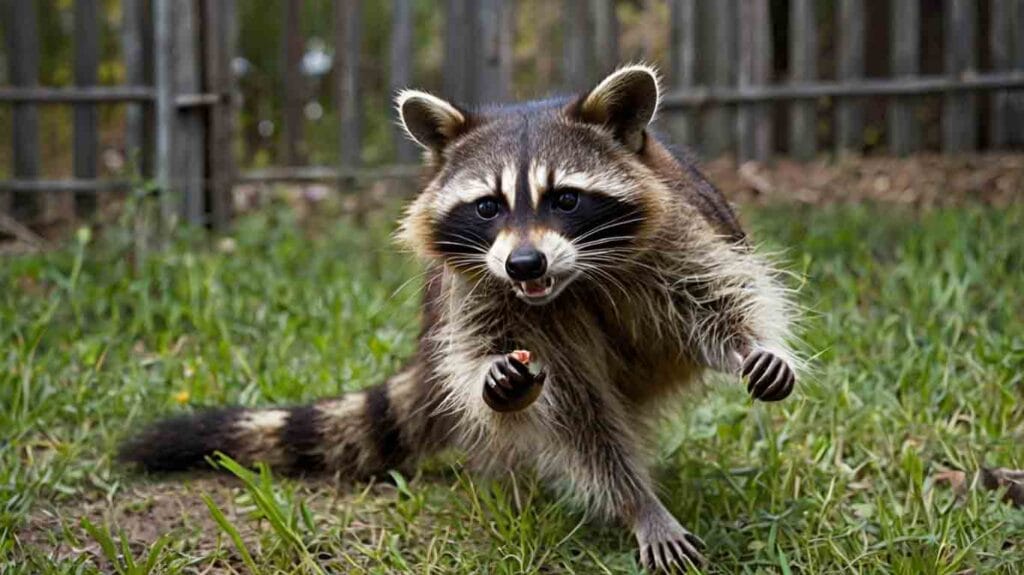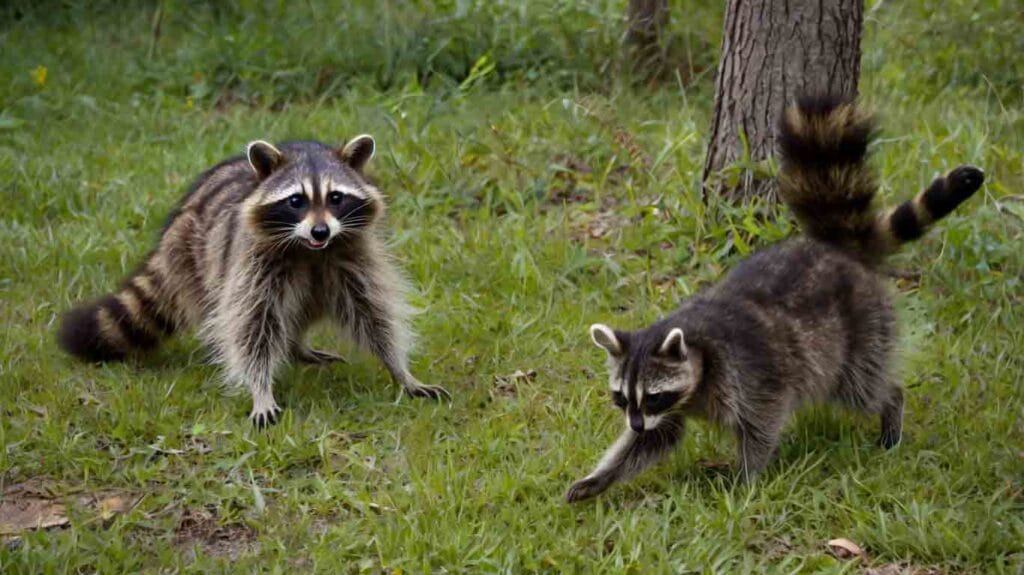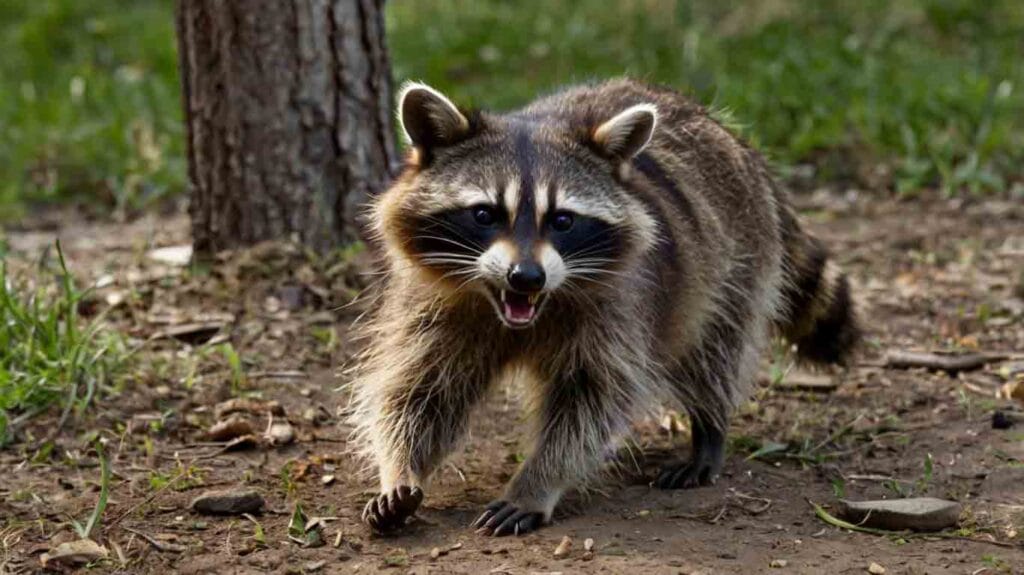The interaction between raccoons and cats is a subject that piques curiosity and concern alike. These two creatures, both familiar yet enigmatic, often share overlapping habitats, leading to potential encounters.
While domestic cats are cherished companions, raccoons are often seen as cunning and opportunistic wildlife.
Understanding the dynamics between these animals is essential for ensuring the safety and well-being of both.
This exploration delves into the health, behaviours, risks, and environmental factors influencing raccoon cat interactions, providing insights for pet owners and wildlife enthusiasts. Let’s dive into can raccoons kill cats.
Understanding Raccoon Behavior
Nocturnal Nature and Habits
Raccoons are predominantly nocturnal creatures, known for their dexterous paws and curious nature.
They forage for food under the cover of darkness, scavenging through garbage bins, gardens, and other accessible areas. Their adaptability to urban environments has made them common residents in cities and suburbs.
This nocturnal behaviour often brings them into contact with domestic cats, who may also roam at night.
Understanding the habits of raccoons is crucial in predicting and managing their interactions with cats, as these encounters typically occur during nighttime hours.
Territorial Instincts
Raccoons possess strong territorial instincts, often defending their chosen habitats from perceived threats.
They establish territories based on the availability of food and shelter, marking their boundaries with scent. When intruders, such as cats, enter these territories, raccoons may exhibit aggressive behaviours to protect their resources.
This territoriality can lead to conflicts, especially in areas where food is scarce.
Recognizing these instincts helps in understanding the potential for aggressive encounters between raccoons and cats, as both animals may vie for the same territory.
Understanding Cat Behavior
Territoriality in Domestic Cats
Cats are inherently territorial animals, with a strong sense of ownership over their home ranges. They mark their territories through scent marking and vocalizations, establishing boundaries that they defend against intruders.

This territorial behaviour is a key factor in their interactions with raccoons, as cats may perceive raccoons as threats to their domain.
The presence of a raccoon in a cat’s territory can trigger defensive and aggressive responses, leading to potential confrontations.
Understanding this behaviour is essential for predicting and managing cat raccoon interactions.
Defensive Mechanisms
Domestic cats possess a range of defensive mechanisms to protect themselves from threats. These include hissing, growling, and swiping with their claws.
In some cases, cats may choose to flee rather than fight, especially if they perceive the threat as overwhelming.
When faced with raccoons, cats may employ these defences to deter the perceived intruder. However, the effectiveness of these mechanisms depends on the individual cat’s temperament and the specific circumstances of the encounter.
Recognizing these behaviours helps in assessing the potential outcomes of raccoon-cat interactions.
Raccoon-Cat Encounters
Typical Scenarios of Interaction
Encounters between raccoons and cats typically occur in urban and suburban settings, where both animals have adapted to coexist with humans.
Common scenarios include raccoons foraging in areas frequented by cats, such as backyards, alleys, and parks. These interactions may be driven by competition for food or territory.
In some cases, a cat’s curiosity may lead it to approach a raccoon, resulting in a confrontation. Understanding these scenarios is crucial for predicting and managing potential conflicts, and ensuring the safety of both animals.
Factors Influencing Encounters
Several factors influence the likelihood and nature of encounters between raccoons and cats. These include the availability of food, the presence of shelter, and the density of the local animal population.
Human activity, such as leaving out pet food or improperly securing garbage, can also attract raccoons and increase the chances of encounters.
Additionally, the individual temperaments of the animals involved play a significant role in determining the outcome of these interactions.
Recognizing these factors helps in developing strategies to prevent and manage raccoon-cat encounters.
Potential Risks for Cats
Physical Threats from Raccoons
Raccoons, despite their typically non-aggressive nature, can pose physical threats to cats, especially if they feel cornered or threatened. Their sharp claws and teeth can inflict serious injuries during a confrontation.

While raccoons generally prefer to avoid conflict, a defensive raccoon may attack if provoked. This potential for physical harm is a significant concern for pet owners, particularly in areas where raccoon populations are high.
Understanding these risks is essential for ensuring the safety and well-being of domestic cats.
Health Risks and Disease Transmission
Beyond physical injuries, raccoons can pose health risks to cats through the transmission of diseases. Raccoons are known carriers of rabies, a viral disease that can be fatal to both animals and humans.
They can also carry other pathogens, such as raccoon roundworm and leptospirosis, which can be transmitted to cats through contact.
These health risks underscore the importance of preventing raccoon cat encounters and ensuring that cats are vaccinated and receive regular veterinary care.
Awareness of these risks is crucial for protecting the health of domestic cats.
Also read: How to Get Cat Pee Out of Carpet? 7 Vet-Approved Tips & FAQs
Potential Risks for Raccoons
Defensive Aggression from Cats
While raccoons can pose threats to cats, the reverse is also true. Cats, with their sharp claws and quick reflexes, can inflict injuries on raccoons during defensive encounters.
A cornered or threatened cat may lash out, causing harm to the raccoon. This potential for aggression highlights the risks raccoons face when interacting with domestic cats.
Understanding these dynamics is important for assessing the outcomes of raccoon-cat encounters and ensuring the safety of both animals.
Human Intervention and Habitat Loss
Raccoons face additional risks from human intervention and habitat loss. As urban development encroaches on natural habitats, raccoons are forced into closer proximity with humans and domestic animals.
This increased interaction can lead to conflicts, resulting in injuries or fatalities for raccoons. Additionally, human efforts to control raccoon populations, such as trapping or poisoning, pose significant threats to their survival.
Recognizing these challenges is essential for developing strategies to coexist with raccoons and protect their habitats.
Also read: How Do Cats Have Sex? 7 helpful Vet’s Guide for Pet Owners
Environmental Considerations
Urban and Suburban Habitats
The overlap of urban and suburban habitats creates a unique environment where raccoons and cats frequently encounter each other.
These areas provide abundant food sources and shelter, attracting both animals. However, the close proximity of these habitats to human activity can exacerbate conflicts and increase the risks of encounters.

Understanding the dynamics of these environments is crucial for managing raccoon-cat interactions and ensuring the safety of both animals and humans.
Impact of Human Activity on Wildlife Interactions
Human activity plays a significant role in shaping the interactions between raccoons and cats. The availability of food, such as unsecured garbage or pet food left outdoors, can attract raccoons and increase the likelihood of encounters.
Additionally, urban development and habitat fragmentation can force wildlife into closer proximity to domestic animals. These impacts highlight the importance of responsible human behaviour in managing raccoon-cat interactions and protecting local wildlife.
Awareness of these factors is essential for fostering a harmonious coexistence between humans, raccoons, and cats.
Also read: Why Does My Cat Run Away From Me? 7 best Vet Advice & FAQ
Safety Tips for Pet Owners
Preventing Raccoon-Cat Encounters
Pet owners can take several measures to prevent encounters between their cats and raccoons. Keeping cats indoors, especially at night, can significantly reduce the risk of interactions.
Securing garbage bins and removing potential food sources can also deter raccoons from entering the area. Additionally, installing motion-activated lights or sprinklers can discourage raccoons from approaching.
These precautions can help protect both cats and raccoons, fostering a safer environment for all.
Responding to Encounters
In the event of a raccoon-cat encounter, it is important for pet owners to remain calm and act swiftly. If possible, safely separate the animals to prevent injury.
Monitor the cat for any signs of distress or injury, and seek veterinary attention if necessary. It is also advisable to observe the raccoon for signs of illness, such as unusual behaviour or aggression, which may indicate rabies.
Understanding how to respond in these situations can ensure the safety and well-being of both the cat and the raccoon.
wrap up on Can Raccoons Kill Cats
The interactions between raccoons and cats are a testament to the complex interplay of nature and domestication. While these encounters can pose risks to both animals, they also offer opportunities for understanding and coexistence.
By recognising the behaviours and needs of raccoons and cats, pet owners and communities can develop strategies to protect both animals and foster a harmonious coexistence.
This balance requires awareness, education, and proactive measures, to ensure the safety and well-being of all involved.
Also read: Will Cats Kill Rats? 5 Vet Tips on Feline Hunting Skills
FAQ: Can Raccoons Kill Cats
Q1: will raccoons kill kittens?
Ans: Kittens may be as much of a threat to raccoons as raccoons are to cats, as raccoons are opportunistic predators; hungry raccoons may prey on kittens who are left unprotected or whose food supply is scarce. To keep kittens safe, do them indoors or in secure enclosures. Keep children away from outdoor time and remove attractants such as garbage and pet food.
Q2: are raccoons a danger to cats?
Ans: Cats that are outside have cause to be on guard against raccoons, which can be hazardous to both them and other cats. Normally raccoons are going to avoid a confrontation but if provoked or feeling threatened, they will attack. They can also spread parasites, or spread diseases, like rabies. Supervise outdoor cats to ensure their safety.
Q3: can a raccoon beat a cat in a fight?
Ans: For being the size they are, and as strong as they can be, with sharp claws, a raccoon can beat a cat in a fight. But fights are rare and both animals generally try to avoid a fight to protect themselves from injury.
Q4: Can Raccoons Kill Cats in the house?
Ans: If raccoons feel threatened or cornered indoors, they will harm or even kill your cats. A wooden screen or inside a cage can be a helpful way to prevent access and don’t leave food out that might attract raccoons.
Q5: Can Raccoons Kill Cats instantly?
Ans: However, raccoons hardly ever kill cats, but confrontations can be dangerous. Raccoons are sadly strong and will sink their canines into your hand if disturbed, that is defending the young or food. They will be deterred by larger cats, but use caution.
